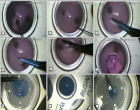Table of Contents
A two-phase sonographic study among women with infertility who first had normal sonographic findings
Published on: 15th December, 2022
Introduction: Sonographic scan tests are real-time procedures but the female reproductive systems are subject to continued changes beyond the mid-menstrual period. Therefore a second test may be useful after mid-menstrual ultrasound tests among women with infertility who first had normal ultrasound tests during the mid-menstrual period. Aim: The aim of this study is to find out whether physiological changes beyond the mid-menstrual period in the female reproductive system could develop into findings that could be missed at the first ultrasound test among women with infertility during mid menstrual period. Method: One hundred and forty (140) women participated in this study, over a period of 12 months. The inter-observer correlations were carried out. The ultrasound test measured the diameters of the endometrium and ovarian follicle. The study was carried out during the mid-menstrual cycle when normal changes are optimal. The subjects were women of childbearing age (18 years - 40 years) with 28 days cycles who were referred from the fertility clinic. Women who had previous pelvic surgery, women on fertility therapy, and women who were unsure of the date were excluded from the study. Only women who met the inclusion criteria were selected for the study. The selection was by convenience sampling method. The women underwent the first phase of the ultrasound test during the mid-menstrual cycle. Those who had ultrasonographic-positive infertility reports were returned to the referral clinic. Only women who had normal ultrasonographic fertility reports were included in the second phase of further ultrasonographic tests. The scans were carried out further for four days for this second phase study and the result was again compared with normal values. (Endometrium Normal range 7.4 mm - 13.5 mm and ovarian follicles normal range 17.4 mm to 23.5 mm). Results: The first phase of the scan showed 108 (77%) of the women had positive infertility results for endometrium and ovarian follicles, while 32 (23%) of the women had a normal ultrasonographic result and were rescanned over days. The findings of the second phase scan showed that 10 subjects (7.30%) showed new abnormalities, Findings were distributed in three sub-groups in this second phase of the study. Sub-group A, 4 (2.67%) had enlarged unruptured follicles, sub-group B, 6 (4.30%) had an endometrial cavity filled with fluid, sub-group C, 22 (15.70%) subjects still had normal scans who may be referred for other studies. Conclusion: Women with infertility who had a normal scan at the mid-menstrual cycle should be followed up with a second-phase ultrasound scan before other tests.
Ovarian lymphoma – A rare presentation
Published on: 6th December, 2022
Non-Hodgkin's lymphoma involving the ovaries is unusual and may cause confusion for the clinician since its presentation could resemble other, more frequent tumors. Malignant lymphoid cells may occur in the ovary either as a primary neoplasm or as a secondary manifestation of a disseminated occult or known disease. The most common presenting symptoms or signs of malignant lymphomas involving the ovaries are abdominopelvic pain or mass.
Abnormal uterine bleeding and severe anemia cause the life-threatening condition
Published on: 22nd November, 2022
The World Health Organisation (WHO) defines anemia as a global public health problem. It is a medical condition in which the number of red blood cells or the hemoglobin concentration within them is below the physiological range. We present a case of a 40-year-old woman with Abnormal Uterine Bleeding (AUB) accompanied by malaise, weakness, and tachycardia. The patient reported heavy menstrual bleeding for the past 14 days. Speculum examination revealed that the bleeding was from the uterus. There were no pathological findings during a gynecological and transvaginal ultrasound examination. A complete blood count performed at the time of her arrival showed a low hemoglobin level of 24 g/L, a low hematocrit level of 7,4%, a mean corpuscular volume of 98,7 fL and a number of red blood cells 0,75 x 1012/L. Due to the severity of the anemia, she was given 6 units of red blood cell transfusion, 2 fresh frozen plasmas and tranexamic acid accompanied with calcium carbonate. The curettage was performed. The pathohistological finding was endometrium in proliferation. Afterward, the hemoglobin level increased to 90 g/L. Their past medical history revealed that she abused alcohol. On an abdominal CT scan, Alcohol-Related Liver Disease (ARLD) was confirmed. We should keep in mind that coagulopathy could be the underlying cause of abnormal uterine bleeding and that anemia must be analyzed for successful treatment. A multidisciplinary approach to anemia caused by AUB is required in cases of severe anemia.
Idiopathic ascites following caesarean section: A case report
Published on: 1st November, 2022
Ms X is a 40-year-old gravida 12, para 2+9 woman, who was admitted for an elective caesarean section at 38 weeks gestation following the previous two caesarean sections. Ms X had abdominal distension and generalised abdominal tenderness in the postoperative period. On investigation, she was found to have an elevated white cell count (WCC), C - Reactive Protein (CRP) and creatinine with free fluid in the abdomen on imaging but there was no evidence of perforation of any visceral organ. Ms X was treated conservatively for sepsis, an Acute Kidney Injury (AKI) and post-operative ileus and her symptoms gradually resolved. This is a case of idiopathic ascites post caesarean delivery with no clear cause.

If you are already a member of our network and need to keep track of any developments regarding a question you have already submitted, click "take me to my Query."


















































































































































